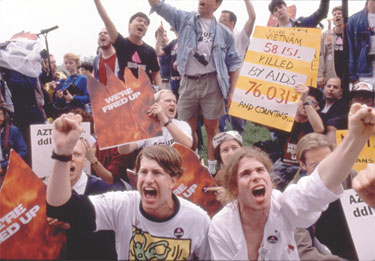I don't have to tell you that How to Survive a Plague is an important film. Nor do I have to tell you that it is difficult to watch. I certainly don't have to remind you that it's about an infuriating, terrifying, altogether preposterous period in American history when the powers-that-be let an untold number of gay men wither away and die. And yet, I want to. The story of how AIDS victims were once treated is so outrageous and embarrassing, it's nearly unbelievable to consider today -- but it happened. It needs to be remembered. We, as a society, need to face and recognize our demons. David France's astonishing, meticulous documentary pulls the skeletons of those demons out of the dark and, perhaps more important, recognizes the heroes who stood on the front lines to fight them. If you care about gay rights, civil disobedience, or social activism, you ought to see How to Survive a Plague. It's a history lesson that boils with indignation.

How to Survive a Plague
The film carefully charts the early years of the AIDS Coalition to Unleash Power, better known as ACT UP, an aggressive gay-rights advocacy group that spontaneously came together at the nadir of the AIDS crisis in 1987. (Later, the documentary also focuses on the Treatment Action Group, a research-minded offshoot of ACT UP.) France, an investigative reporter who has spent decades covering gay-rights issues, combed through hundreds of hours of footage provided by dozens of sources to weave together the group's history. It's an inspiring method of storytelling that keeps attention toward the filmmakers -- the original ones who filmed on camcorders during ACT UP's rallies and demonstrations -- and carries with it their cavalcade of emotions.
In fact, How to Survive a Plague crackles with emotions. Enraged activists whip themselves into a furor over the spread of AIDS and lack of effective medicine. "It's like living in a war,'' say Peter Staley, one of a handful of infected men profiled in the documentary. ''All around me, friends are dropping dead.'' The hollowed-out faces of victims stare off hopelessly, their bodies decaying to skin and bones while treatment lingers outrageously, impossibly near. There's a troubling, macabre thrill to it all; there's a life-or-death immediacy to the struggle. These people were forced to fight for their lives. Ordinarily, that sort of madness is difficult to conjure, but France's trick involves no magic. The footage he's curated speaks for itself, needing little more than a light touch to kick start a brisk, ingenious tour of ACT UP and TAG working to stop an epidemic.
How to Survive a Plague isn't merely a snapshot of ACT UP and TAG, though. (Even if it were only that, I'd like to add, it would still be worth twice the price of admission.) It's also an astonishingly straightforward blueprint for contemporary political activism -- with all of the messy, volatile problems that social-justice movements typically invite. There's not a direct relationship between these groups and, say, the ''occupy'' movements or other well-known protests, but France seems well aware of how the imagery stirs up vague similarities. At one point, testy infighting about the group's flamboyant protests threatens to tear ACT UP apart until famed playwright Larry Kramer erupts in anger, bellowing: ''Plaaaaague! Plaaaaague! We are in the middle of a fucking plague!'' It's a hair-raising reminder of what they're fighting for, what's at stake, and why other protest movements can appear so benign in comparison.
Those stakes are the fundamental backbone of France's documentary. As he thoroughly explains, the activists didn't know the science of HIV and AIDS, so they educated themselves. They didn't understand the legal barriers of the pharmaceutical industry, so they figured out how to overcome them. This is, quite easily, their strongest enduring legacy – it's no exaggeration to say that many of them had to teach themselves to save themselves. Unfortunately, with homophobic bigots like Jesse Helms standing in their way, they had no other choice.
HOW TO SURVIVE A PLAGUE



 Directed by David France Not Rated 120 minutes Opens Oct. 12 Landmark E Street
Directed by David France Not Rated 120 minutes Opens Oct. 12 Landmark E Street
How to Survive a Plague has no shortage of villains who, like Helms, were targeted by ACT UP's rowdy protests. They stretched a gigantic yellow ''condom'' over Helms's house. A controversial ''die-in'' at St. Patrick's Cathedral in New York led to police arresting dozens of activists. Bob Rafsky, a man with full-blown AIDS, infamously heckled Bill Clinton during a press conference. In a shockingly emotional scene, ACT UP members even tossed the ashes of AIDS victims onto the White House lawn. It all makes sense, though, for an activist group who adopted the slogan ''Silence = Death.'' The protests got the public's attention about a dire crisis, TAG encouraged the necessary medical innovations, and within years, pharmaceutical ''cocktails'' were put on the market that could effectively stave off AIDS. To date, the film's epilogue notes, similar drugs have saved millions of people.
So, there is more to How to Survive a Plague than righteous indignation. It's also a story about hope. It's a reminder that at its darkest hour, the gay community banded together to save itself. Or, as Kramer puts it in the film's closing minutes: ''The government didn't get us the drugs. No one else got us the drugs. We got those drugs out there. That is the proudest achievement that the gay population of this world can ever claim.''
...more